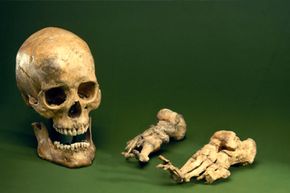Riddled with sores, maybe missing toes, definitely unclean. Lepers spark some pretty hideous things in our imaginations, don't they? That's imagination and NOT reality. Yet there's a long-standing stigma when it comes to this disease; think about what you're really saying when you call someone a leper. It was even once believed the victims of the diseases were, actually, victims of sin (mentioned — through possible dubious translation — in Leviticus 13:14 in the Old Testament). Although leprosy has a history of being thought of as a highly-contagious (it's not) and deadly, it's actually totally treatable. And there's such a low risk of transmission there's no reason to isolate or ostracize people with leprosy.
Leprosy has been with us since roughly 1500 B.C.E. (that's when it's first mentioned in the Egyptian Ebers Papyrus, but it's also mentioned in other ancient writings, including in prehistoric Asian writings dating to 600 B.C.E.). But it's probably been plaguing humans for much longer, at least since the ancient civilizations of China, Egypt and India. In 2009, anthropologists discovered evidence of leprosy in a 4,000-year-old skeleton, which dates the infection back to prehistoric India, around 2000 B.C.E. [source: Robbins]. Scientists theorize that the infection spread as empires and trade routes grew, and that it likely arrived in the Americas during European exploration of the New World.
Advertisement
In 1866, after leprosy began infecting Hawaiians, the Kalaupapa peninsula of the island of Molokai was turned into the first leprosy colony — which it remained through 1969. (That's is about a decade after Hawaii became a U.S. state). Eight thousand Hawaiians were sent to live (and die) there, quarantined in an effort to prevent the disease from spreading. Today the only leprosy victims living on Kalaupapa number only about a few more than dozen or so; there are more tourists.
Modern-day medicine has renamed leprosy to Hansen's disease (HD), after Gerhard Henrik Armauer Hansen, the scientist who discovered the cause of the infection — a germ — back in 1873. Although it's not eradicated, not many cases appear these days; in fact, in 2012 there were only 232,857, and those that do pop up are usually contained in 16 countries, mainly in the tropics. The U.S. isn't immune from the disease, but incidents are few. There were only 213 new cases of leprosy reported in the U.S. in 2009 (most occurred in California, Florida, Hawaii, Louisiana, Massachusetts, New York, and Texas, and most occurred in people who had recently immigrated). In total there are about 6,500 people living with leprosy in the U.S. (including some who still live on Molokai), and typically between 150 to 250 newly diagnosed infections every year [sources: National Hansen's Disease (Leprosy) Program , Doerr]. And let this ease your mind: About 95 percent of humans are naturally immune to the infection.
Advertisement


